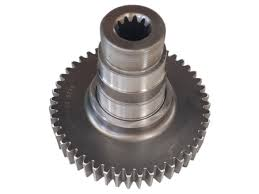
How to reduce transmission noise and improve meshing smoothness in heavy truck gears?
Publish Time: 2025-11-14
In the powertrain system of heavy trucks, the heavy truck gear, as a core component for power transmission, directly affects the overall NVH performance, transmission efficiency, and reliability of the vehicle through its transmission noise and meshing smoothness.1. Generation Mechanism of Gear Transmission NoiseGear transmission noise mainly originates from vibration excitation during gear meshing. When gear pairs mesh under load, manufacturing deviations such as tooth profile errors and tooth pitch errors occur, causing instantaneous changes in the transmission ratio and generating meshing impact. This impact is transmitted to the gearbox housing through the shaft system and bearings, causing vibration on the housing surface and ultimately radiating air noise.In heavy truck gearboxes, gear noise mainly manifests as high-frequency "whistling" and mid-to-low-frequency "roaring." Whistling is usually related to the gear meshing frequency and its harmonics, while roaring is more related to torsional vibration and structural resonance of the shaft system. Understanding the generation mechanism of these noises is a prerequisite for taking effective control measures.2. Optimization Strategies in Gear DesignIn the gear design stage, reasonable parameter selection and structural optimization can improve gear meshing performance from the source. First, adopting a high contact ratio design is an effective way to improve meshing smoothness. By optimizing parameters such as helix angle and module, increasing the contact ratio to above 2.0 ensures that at least two pairs of teeth are engaged simultaneously at all times, thereby reducing the load on a single pair of teeth and minimizing transmission fluctuations.Second, the application of profile modification techniques is crucial. This includes both profile modification and tooth direction modification. Profile modification removes a small amount of material at the tooth tip and root to avoid edge contact caused by stress deformation; tooth direction modification, by machining the tooth surface into a drum shape, compensates for shaft deformation and assembly errors, ensuring uniform load distribution along the tooth width. Reasonable profile modification design can effectively reduce meshing impact, vibration, and noise.Furthermore, asymmetric tooth profile design also shows unique advantages. By increasing the working side pressure angle and decreasing the non-working side pressure angle, meshing smoothness is improved while maintaining strength. This design is particularly suitable for the operating conditions of heavy-duty trucks.3. Precision Control of Manufacturing ProcessesPrecision manufacturing processes are crucial for achieving design intent. In gear machining, ensuring tooth profile errors are controlled at the micron level is essential. CNC forming and grinding technology not only guarantees tooth profile accuracy but also precisely achieves the required profile modification curves.Controlling the heat treatment process is equally critical. Carburizing and quenching is the most common heat treatment process for heavy truck gears, but heat treatment deformation is a significant factor affecting gear precision. Advanced technologies such as controlled atmosphere carburizing and pressure quenching can effectively control heat treatment deformation. Furthermore, appropriate stress relief treatment after heat treatment can significantly improve the dimensional stability of the gears.Surface quality control is also paramount. Honing, grinding, and other finishing processes can reduce tooth surface roughness, improve tooth texture direction, and reduce friction and vibration.4. Innovative Applications of Materials ScienceThe selection of gear materials directly affects their mechanical properties and noise characteristics. After carburizing and quenching, these materials achieve high surface hardness while maintaining sufficient toughness in the core, ensuring both load-bearing capacity and good impact resistance. In recent years, the development of new gear materials has offered new possibilities for noise control. The application of fine-grained steel allows gears to achieve a more uniform microstructure and less deformation after heat treatment. Simultaneously, by optimizing the damping characteristics of materials and developing high-damping composite materials, vibration energy can be directly consumed, reducing noise along the transmission path.In lubrication technology, the development of high-performance gear oils also plays a crucial role. Appropriate lubricant viscosity combined with extreme pressure anti-wear additives can form a stable lubricating film between the gear teeth, not only reducing wear but also providing damping and vibration reduction. Studies have shown that using gear oils containing special vibration-damping additives can reduce transmission noise by 1-2 decibels.5. System-Level Integrated OptimizationGear noise control should not be limited to the gears themselves but should be optimized from the perspective of the entire transmission system. First, the stiffness design of the shaft system is crucial. Sufficient shaft stiffness ensures that gears maintain the correct meshing position under various operating conditions, avoiding meshing deterioration due to deformation.Secondly, the structural optimization of the gearbox housing is also indispensable. By strengthening the rigidity of the gearbox and optimizing the bearing housing structure, the system's natural frequency can be increased, preventing resonance with the gear meshing frequency. Simultaneously, designing appropriate lubrication channels within the gearbox ensures adequate gear lubrication, effectively reducing noise.Finally, the matching and tuning of the transmission system is equally important. Optimizing the speed ratio distribution prevents gears from operating in the resonant speed range under normal conditions, reducing noise from a usability perspective. Furthermore, using vibration isolation devices such as dual-mass flywheels can reduce the transmission of engine torsional vibration to the transmission system, indirectly improving gear meshing conditions.



